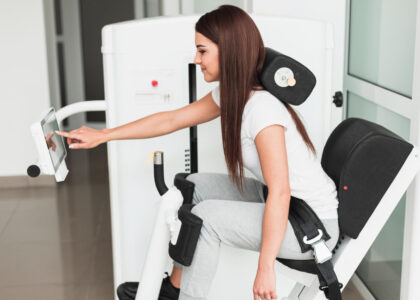Standing Calves | Leg Workout | Upper Chest | Face Pull |
Doing a single sit-up can seem impossible for many people. Trust me, I get it – I’ve been there too! As a long-time fitness coach, one of the most frequent questions I receive is “why can’t I do a single sit up?“.
I totally understand the frustration. Sit-ups seem like such a basic move, the type of exercise you likely did effortlessly in elementary school gym class. Yet now, as an adult, you may struggle to even get your shoulders off the floor. Annoying doesn’t even begin to describe it!
In my experience, the inability to perform sit-ups is rarely due to one clear-cut reason. Often, there are underlying mobility restrictions, stability weaknesses, and technique faults holding you back from sit-ups.The good news is that by targeted core strengthening modalities, adjustments in form, and consistency in your training, the sit-ups struggle can be overcome. I’m going to break down some of the most common culprits of sit-ups. I’ll also provide you with step-by-step recommendations to start progressing towards proper sit-up execution.
So don’t fret if sit ups are impossible for you right now. With some adjustments and determination, you’ll be knocking them out in no time! Keep reading to discover strategies to advance from zero.
Here are 7 common reasons someone may be unable to complete a single sit up:
1. Underdeveloped abdominal muscles :
When you don’t work out your core for a long time, your abdominal muscles can lose strength and size. The main ab muscles used in sit-ups are the rectus abdominis (the “six pack” straight down the front), the transverse abdominis (deepest layer that wraps around your sides), and the obliques (running along your side waist area). You need these muscles to be strong and properly activated to curl your upper body off the floor.
If you take a long break from core moves like crunches or planks, your ab muscles lose conditioning – they lack the strength, endurance and neural connection to perform even one good sit-up. It takes, over months or years, to rebuild that abdominal muscle mass and ability to flex. If your ab muscles are too weak to create sufficient tension, they can’t hold your top half against gravity to complete a sit-up.
2. Tight hip flexors and quadriceps :
Your hip flexors are muscles that connect your lower spine and pelvis to your thighs. If these muscles are very tight or short, it becomes very hard and uncomfortable to curl your torso upwards from lying down while properly tilting your pelvis and bending at the waist. Your quadriceps (thigh muscles) also matter – if your quads are too stiff or short, you’ll struggle to roll your pelvis under you the right way as you get ready for a sit up.
Without enough flexibility in these hip and thigh muscles, you simply won’t have the necessary range of motion to do correct sit ups. This puts excessive strain on other areas like your lower back since you know that you lack the smooth coordination between upper and lower body that is needed to safely and effectively perform sit ups.
3. Poor exercise technique :
Many people do sit-ups incorrectly – pulling up forcefully with their arms, swinging momentum to curl up, or crunching their head forward instead of properly rolling the whole spine. These mistakes strain tissues in harmful ways without working the abs well. A proper sit-up means slowly rolling each vertebra to safely target the abdominals. Retraining basics like rib to pelvis motion, shoulder positioning, neck alignment, and hip angles takes patience and coaching from a trainer. But learning how to activate your core during the move and do sit-ups with good form markedly improves exercise quality and abdominal strengthening.
4. Lack of simultaneous spinal stability :
When doing a full sit-up range of motion, the spine must be stabilized one vertebrae at a time. Moving your trunk while keeping the spinal joints aligned and secure requires outstanding muscle control over your core. If you have not focused on basic control exercises for your midsection, or trained how to brace with your deep abdominal muscles, the complex task of both stabilizing AND moving your spine during sit-ups might be too hard given your current capability. Trying dynamic sit-ups too aggressively without building this stability often leads to strain and soreness in the back afterwards or the next day.
5. Tight hamstrings :
Your hamstrings and other muscles along the back of your legs play an important role for sit-ups. If your hamstrings are really tight and inflexible, it greatly reduces how much you can tilt your pelvis backwards when getting set up to start a sit-up. Without flexible hamstrings to enable normal pelvis mobility on the floor, you can’t properly tilt your pelvis to make a stable base for your abs to then curl your upper body upwards. Stiff hamstrings fail to provide the necessary mobility for your pelvis and spine to go through the complete sit-up range of motion. This throws off the sequenced chain of muscle actions and prevents your abs from activating properly.
6. No mind-muscle connection :
Those newer to core training often lack body awareness and ability to consciously activate key abs muscles like the transverse or obliques. Without intentionally bracing by drawing in the deepest abdominal wall or feeling a distinct contraction along the side waist, sit-up attempts involve straining with poor form using the wrong muscles. This not only risks injury but prevents strengthening the abs. Building mind-muscle connection through visualization and coaching enables detecting proper abdominal activation. Repeated practice improves the mind-body connections over time, making sit-ups achievable as you learn to better engage the target muscles.
7. Lack of confidence :
Mental barriers can strongly impact physical ability. If someone feels defeated about ever doing a sit-up or expects pain and frustration, this compounds existing mobility restrictions or stability issues. Negative thoughts prevent proper muscle activation and ability to improve technique. Building confidence by adjusting attitude, focusing on a trainer’s guidance rather than self-criticism, and celebrating small wins like holding an abs contraction can bolster belief over time. A defeatist mindset often results in poor training so that no mobility worksZ. A growth-oriented, resilient mentality empowers capability – if you believe you can improve, you often will.
Proper sit up technique :
- Lie on your back with knees bent at 90 degrees and feet hip-width apart on the floor to engage hip extensors.
- After that, tilt your pelvis posteriorly to flatten your lower back against the mat to protect your spine.
- Then activate your core by drawing your lower abs in and up gently before moving.
- Keep your chin slightly up and engage your neck to lift your head off the floor first while maintaining neck position.
- Then lift the top part of your ribcage next to start mobilizing your thoracic spine area of your upper back.
- Use your abdominals to curl your shoulders up slightly while keeping your lower ribs grounded on the floor.
- Lift up until your shoulder blades slightly come off the ground, then lower back down slowly with the same amount of control.
Conclusion for why can’t I do a single sit up? :
As outlined, many factors ranging from weak cores, tight muscles, to poor form could create quit result in [ Why can’t I do a single sit up? ]. With targeted core and posture work, stretching tight areas, plank progressions, and learning good movement, sit-ups can go from extremely challenging to achievable. Be patient where you’re at and celebrate small gains. Over time, great improvements in muscle strength, stability, movement control, and confidence will build.
The strategies shared for identifying and addressing that why you struggle with sit-upsand will give you the path to eventually performing controlled reps. Also, consider a qualified trainer, if needing attentive cueing and programs designed for your current baseline ability. With the proper tailored stimulus over time, strengthening sit-up capability lies within your grasp, no matter how unattainable it feels now.







